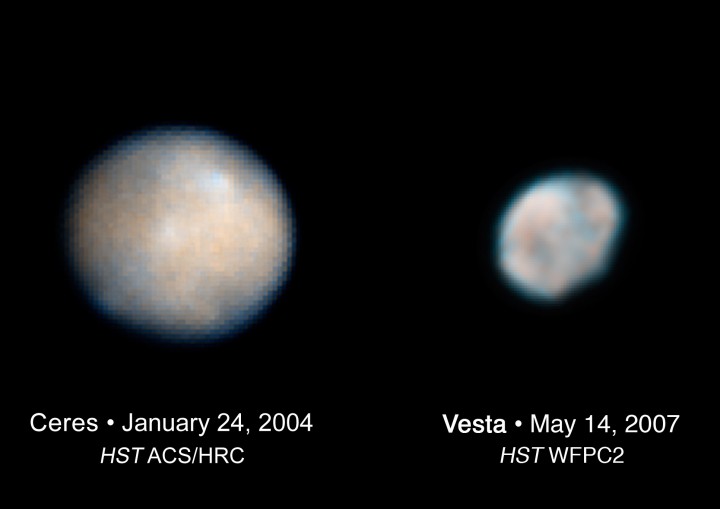 |
Астронет: Астрономическая картинка дня Маленькие планеты Церера и Веста http://variable-stars.ru/db/msg/1222481/eng |
Credit & Copyright: NASA,
ESA,
L.McFadden, J.Y.Li (UMCP),
M.Mutchler, Z.Levay (STScI),
P.Thomas (Cornell),
J.Parker, E.Young (SwRI), C.Russell, B.Schmidt (UCLA)
Explanation:
Ceres and
Vesta are, respectively, only
around 950 kilometers and 530 kilometers in diameter - about
the size of Texas and Arizona.
But they are two of the largest of over 100,000
minor bodies
orbiting in the main asteroid belt between Mars and Jupiter.
These remarkably detailed
Hubble Space Telescope images
show brightness and color variations
across the surface of the two small worlds.
The variations could represent large scale
surface features or areas of different compositon.
The Hubble image data will help astronomers plan for a
visit by the asteroid-hopping
Dawn spacecraft,
scheduled for launch on July 7 and intended to orbit first
Vesta and then
Ceres after a four year interplanetary cruise.
Though
Shakespeare might not have been impressed,
nomenclature introduced by the International Astronomical
Union in 2006 classifies nearly spherical Ceres as a
dwarf planet.
J.Parker, E.Young (SwRI), C.Russell, B.Schmidt (UCLA)
Authors & editors:
Robert Nemiroff
(MTU) &
Jerry Bonnell
(USRA)
NASA Web Site Statements, Warnings,
and Disclaimers
NASA Official: Jay Norris.
Specific
rights apply.
A service of:
LHEA at
NASA /
GSFC
& Michigan Tech. U.
